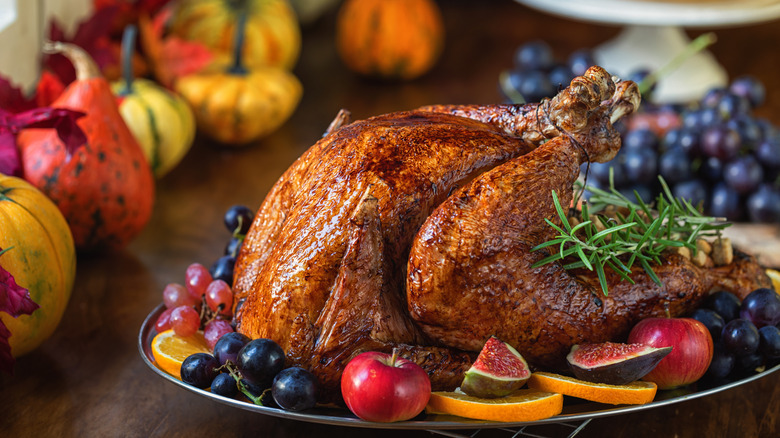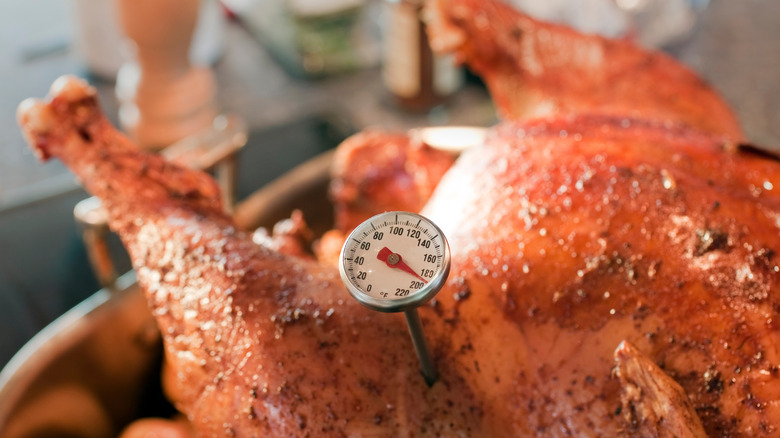An Expert Explains The Biggest Mistakes You're Making With Roast Turkey
We may receive a commission on purchases made from links.
We've all had at least one turkey-gone-wrong experience, whether it was undercooked, overcooked, or roasted with inedible items accidentally left inside. While it's common for many first-time Thanksgiving dinner warriors, and even seasoned cooks, to make mistakes, a few big ones are avoidable. To find out what not to do, Daily Meal turned to the expertise of Jessie-Sierra Ross, a former ballerina turned cooking and home entertaining author of "Seasons Around the Table; Effortless Entertaining with Floral Tablescapes & Seasonal Recipes."
Jessie-Sierra said that one of the biggest mistakes everyone makes when cooking Thanksgiving turkey is not brining the bird first. Soaking it in a salt solution imparts flavor, keeps the meat moist, and makes the skin crispy as it cooks. "The salt brine acts in two ways: It draws out some of the extra injected liquids that commercially raised turkeys are subjected to, and it flavors the meat," she explained. You can make the brine with cold water, salt, and spices, or purchase a prepackaged mixture. Jessie-Sierra soaks her thawed turkey in a large sealed stock pot or brining bag that she places in an ice-filled cooler for at least 24 hours while maintaining a decent ice level for the duration.
On the other hand, you could get the new Butterball cook-from-frozen turkey, which implements innovative technology so that you don't have to thaw, brine, season, or baste. Even then, there are a couple of other big mistakes that Jessie-Sierra says can be avoided when roasting turkey for Thanksgiving.
Not using a proper thermometer (correctly) is a no-go
Another major no-no that many people unwittingly do when roasting Thanksgiving turkey is rely too much on timers and built-in, pop-up thermometers that are supposed to rise out of the bird when it's done. These methods of determining doneness just aren't reliable enough to avoid undercooking and overcooking the meat.
Jessie-Sierra Ross doesn't like to guess when poultry has been cooked all the way through. "After much experimenting with different techniques, I've settled on this simple roasting method; I roast my turkey in a [400-degree Fahrenheit] oven, and use a continuous-read digital thermometer to keep track of the internal temperatures," she explains. To avoid the meat thermometer placement mistake, check the temperature in three areas: The thickest part of the breast from the side, the innermost area of the thigh, and the innermost point of the wing — all without touching bone.
Jessie-Sierra also suggested pulling the turkey out of the oven when the thermometer reaches 15 degrees below your target (which is 165 degrees for poultry). She noted, "[...] the core will continue to cook out of the oven. This is called 'carry over cooking'."
Plus, although classic Thanksgiving stuffing likely originated in ancient Rome and Jessie-Sierra recommends against making it in the turkey cavity, she says that leaving the cavity empty is a big mistake. That space needs to have something in it so that the bird cooks evenly. Instead of a grain-based stuffing, Jessie-Sierra likes to add halved apples, onions, and fresh herbs to give the meat and drippings additional flavor.

